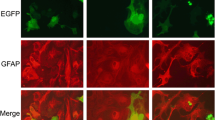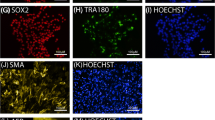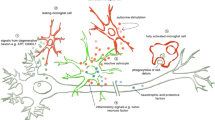Abstract
In the rat model of amyotrophic lateral sclerosis expressing the G93A superoxide dismutase-1 mutation, motor neuron death and rapid paralysis progression are associated with the emergence of a population of aberrant glial cells (AbAs) that proliferate in the degenerating spinal cord. Targeting of AbAs with anti-neoplasic drugs reduced paralysis progression, suggesting a pathogenic potential contribution of these cells accelerating paralysis progression. In the present study, analyze the cellular and ultrastructural features of AbAs following their isolation and establishment in culture during several passages. We found that AbAs exhibit permanent loss of contact inhibition, absence of intermediate filaments and abundance of microtubules, together with an important production of extracellular matrix components. Remarkably, AbAs also exhibited exacerbated ER stress together with a significant abundance of lipid droplets, as well as autophagic and secretory vesicles, all characteristic features of cellular stress and inflammatory activation. Taken together, the present data show AbA cells as a unique aberrant phenotype for a glial cell that might explain their pathogenic and neurotoxic effects.






Similar content being viewed by others
References
Baker DJ, Blackburn DJ, Keatinge M, Sokhi D, Viskaitis P, Heath PR, Ferraiuolo L, Kirby J, Shaw PJ (2015) Lysosomal and phagocytic activity is increased in astrocytes during disease progression in the SOD1G93A mouse model of amyotrophic lateral sclerosis. Front Cell Neurosci. https://doi.org/10.3389/fncel.2015.00410
Boillée S, Vande Velde C, Cleveland DW (2006) ALS: a disease of motor neurons and their non neuronal neighbors. Neuron 52:39–59
Cassina P, Cassina A, Pehar M, Castellanos R, Gandelman M, de León A, Robinson KM, Mason RP, Beckman JS, Barbeito L, Radi R (2008) Mitochondrial dysfunction in SOD1G93A-bearing astrocytes promotes motor neuron degeneration: prevention by mitochondrial-targeted antioxidants. J Neurosci 28:4115–4122
Cleveland DW, Rothstein JD (2001) From Charcot to Lou Gehrig: deciphering selective motor neuron death in ALS. Nat Rev Neurosci 2:806–819
Cudkowicz ME, Warren L, Francis JW, Lloyd KJ, Friedlander RM, Borges LF, Kassem N, Munsat TL, Brown RH Jr (1997) Intrathecal administration of recombinant human superoxide dismutase 1 in amyotrophic lateral sclerosis: a preliminary safety and pharmacokinetic study. Neurology 49:213–222
Das MM, Svendsen CN (2015) Astrocytes show reduced support of motor neurons with aging that is accelerated in a rodent model of ALS. Neurobiol Aging 36:1130–1139
Di Giorgio FP, Boulting GL, Bobrowicz S, Eggan KC (2008) Human embryonic stem cell-derived motor neurons are sensitive to the toxic effect of glial cells carrying an ALS-causing mutation. Cell Stem Cell 3:637–648
Díaz-Amarilla P, Olivera-Bravo S, Trias E, Cragnolini A, Martínez-Palma L, Cassina P, Beckman J, Barbeito L (2011) Phenotypically aberrant astrocytes that promote motoneuron damage in a model of inherited amyotrophic lateral sclerosis. Proc Natl Acad Sci U S A 108:18126–18131
Falchi AM, Sogos V, Saba F, Piras M, Congiu T, Piludi M (2013) Astrocytes shed large membrane vesicles that contain mitochondria, lipid droplets and ATP. Histochem Cell Biol 139:221–231
Fischer LR, Culver DG, Tennant P, Davis AA, Wang M, Castellano-Sanchez A, Khan J, Polak MA, Glass JD (2004) Amyotrophic lateral sclerosis is a distal axonopathy: evidence in mice and man. Exp Neurol 185:232–240
Gallagher CM, Walter P (2016) Ceapins inhibit ATF6a signaling by selectively preventing transport of ATF6a to the Golgi apparatus during ER stress. eLife 5:e11880
Gurney ME, Pu H, Chiu AY, Dal Canto MC, Polchow CY, Alexander DD, Caliendo J, Hentati A, Kwon YW, Deng HX (1994) Motor neuron degeneration in mice that express a human cu,Zn superoxide dismutase mutation. Science 264:1772–1775
Haidet-Phillips AM, Hester ME, Miranda CJ, Meyer K, Braun L, Frakes A, Song S, Likhite S, Murtha MJ, Foust KD, Rao M, Eagle A, Kammesheidt A, Christensen A, Mendell JR, Burghes AH, Kaspar BK (2011) Astrocytes from familial and sporadic ALS patients are toxic to motor neurons. Nat Biotechnol 29:824–828
Hassell JR, Kane BP, Etheredge LT, Valkov N, Birk DE (2008) Increased stromal extracellula matrix synthesis and assembly by insulin activated bovine keratocytes cultured under agarose. Exp Eye Res 87:604–611
Herrera F, Martin V, Carrera P, García-Santos G, Rodriguez-Blanco J, Rodriguez C, Antolín I (2006) Tryptamine induces cell death with ultrastructural features of autophagy in neurons and glia: possible relevance for neurodegenerative disorders. Anat Record 288:1026–1030
Hetz C, Thielen P, Matus S, Nassif M, Court F, Kiffin R, Martinez G, Cuervo AM, Brown RH, Glimcher LH (2009) XBP-1 deficiency in the nervous system protects against amyotrophic lateral sclerosis by increasing autophagy. Genes Dev 23:2294–2306
Howland DS, Liu J, She Y, Goad B, Maragakis NJ, Kim B, Erickson J, Kulik J, DeVito L, Psaltis G, De Gennaro LJ, Cleveland DW, Rothstein JD (2002) Focal loss of the glutamate transporter EAAT2 in a transgenic rat model of SOD1 mutant-mediated amyotrophic lateral sclerosis (ALS). Proc Natl Acad Sci U S A 99:1604–1609
Hur YS, Kim KD, Paek SH, Yoo SH (2010) Evidence for the existence of secretory granule (dense-Core vesicle)-based inositol 1,4,5-trisphosphate-dependent Ca2+ signaling system in astrocytes. PLoS ONE. https://doi.org/10.1371/journal.pone.0011973
Ilieva H, Polymenidou M, Cleveland DW (2009) Non–cell autonomous toxicity in neurodegenerative disorders: ALS and beyond. J Cell Biol 187:761–772
Kabeya Y, Mizushima N, Ueno T, Yamamoto A, Kirisako T, Noda T, Kominami E, Ohsumi Y, Yoshimori T (2000) LC3, a mammalian homologue of yeast Apg8p, is localized in autophagosome membranes after processing. EMBO J 19:5720–5728
Kawamata H, Manfredi G (2010) Mitochondrial dysfunction and intracellular calcium dysregulation in ALS. Mech Ageing Dev 131:517–526
Kondo S, Murakami T, Tatsumi K, Ogata M, Kanemoto S, Otori K, Iseki K, Wanaka A, Imaizumi K (2005) OASIS, a CREB/ATF-family member, modulates UPR signalling in astrocytes. Nat Cell Biol 7:186–194
Lee S, Shang Y, Redmond SA, Urisman A, Tang AA, Li KH, Burlingame AL, Pak RA, Jovičić A, Gitler AD, Wang J, Gray NS, Seeley WW, Siddique T, Bigio EH, Lee VM, Trojanowski JQ, Chan JR, Huang EJ (2016) Activation of HIPK2 promotes ER stress-mediated neurodegeneration in amyotrophic lateral sclerosis. Neuron 91:41–55
Li YR, King OD, Shorter J, Gitler AD (2013) Stress granules as crucibles of ALS pathogenesis. J Cell Biol 201:361–372
Liu L, Zhang K, Sandoval H, Yamamoto S, Jaiswal M, Sanz E, Li Z, Hui J, Graham BH, Quintana A, Bellen HJ (2015) Glial lipid droplets and ROS induced by mitochondrial defects promote neurodegeneration. Cell 160:177–190
Mourelatos Z, Hirano A, Rosenquist AC, Gonatas NK, Fragmentation of the Golgi apparatus of motor neurons in amyotrophic lateral sclerosis (ALS) (1994) Clinical studies in ALS of Guam and experimental studies in deafferented neurons and in beta,beta'-iminodipropionitrile axonopathy. Am J Pathol 144:1288–1300
Mourelatos Z, Gonatas NK, Stieber A, Gurney ME, Dal Canto MC (1996) The Golgi apparatus of spinal cord motor neurons in transgenic mice expressing mutant cu,Zn superoxide dismutase becomes fragmented in early, preclinical stages of the disease. Proc Natl Acad Sci U S A 93:5472–5477
Nagai M, Re DB, Nagata T, Chalazonitis A, Jessell TM, Wichterle H, Przedborski S (2007) Astrocytes expressing ALS-linked mutated SOD1 release factors selectively toxic to motor neurons. Nat Neurosci 10:615–622
Nakatsuji Y, Miller RH (2001) Density dependent modulation of cell cycle protein expression in astrocytes. J Neurosci Res 66:487–496
Nixon RA, Wegiel J, Kumar A, Yu WH, Peterhoff C, Cataldo A, Cuervo AM (2005) Extensive involvement of autophagy in Alzheimer disease: an immuno-electron microscopy study. J Neuropathol Exp Neurol 64:113–122
Olivera-Bravo S, Fernández A, Sarlabós MN, Rosillo JR, Casanova G, Jiménez M, Barbeito L (2011) Neonatal astrocyte damage is sufficient to trigger progressive striatal degeneration in a rat model of glutaric academia-I. PLoS ONE. https://doi.org/10.1371/journal.pone.0020831
Ozawa H, Takata K (1995) The Granin family-its role in sorting and secretory granule formation. Cell Struct Func 20:415–420
Peters A, Palay SL, deF Webster H (1991) The fine structure of the nervous system. Neurons and their supporting cells. Oxford University Press, New York
Re DB, Le Verche V, Yu C, Amoroso MW, Politi KA, Phani S, Ikiz B, Hoffmann L, Koolen M, Nagata T, Papadimitriou D, Nagy P, Mitsumoto H, Kariva S, Wichterle H, Henderson CE, Przedborski S (2014) Necroptosis drives motor neuron death in models of both sporadic and familial ALS. Neuron 81:1001–1008
Robert F, Hervor TK (2007) Abnormal organelles in cultured astrocytes are largely enhanced by streptomycin and intensively by gentamicin. Neuroscience 144:191–197
Rosen DR (1993) Mutations in cu/Zn superoxide dismutase gene are associated with familial amyotrophic lateral sclerosis. Nature 364:362
Sasaki S, Iwata M (1996) Dendritic synapses of anterior horn neurons in amyotrophic lateral sclerosis: an ultrastructural study. Acta Neuropathol 91:278–283
Song SW, Miranda CJ, Braun L, Meyer K, Frakes AE, Ferraiuolo L, Likhite S, Bevan AK, Foust KD, McConnell MJ, Walker CM, Kaspar BK (2016) MHC class I protects motor neurons from astrocyte-induced toxicity in amyotrophic lateral sclerosis (ALS). Nat Med 22:397–403
Suzuki H, Matsuoka M (2012) TDP-43 toxicity is mediated by the unfolded protein response-unrelated induction of C/EBP homologous protein expression. J Neurosci Res 90:641–647
Thiam AR, Farese RV Jr, Walther TC (2013) The biophysics and cell biology of lipid droplets. Nat Rev Mol Cell Biol 14:775–786
Toru-Delbauffe D, Baghdassarian D, Both D, Bernard R, Rouget P, Pierre M (1992) Effects of TGFβ1 on the proliferation and differentiation of an immortalized astrocyte cell line: relationship with extracellular matrix. Exp Cell Res 202:316–325
Trias E, Díaz-Amarilla P, Olivera-Bravo S, Isasi E, Drechsel DA, Lopez N, Bradford CS, Ireton KE, Beckman JS, Barbeito LH (2013) Phenotypic transition of microglia into astrocyte-like cells associated with disease onset in a model of inherited ALS. Front Cell Neurosci. https://doi.org/10.3389/fncel.2013.00274
Trias E, Ibarburu S, Barreto-Núñez R, Babdor J, Maciel TT, Guillo M, Gros L, Dubreuil P, Díaz-Amarilla P, Cassina P, Martínez-Palma L, Moura IC, Beckman JS, Hermine O, Barbeito L (2016) Post-paralysis tyrosine kinase inhibition with masitinib abrogates neuroinflammation and slows disease progression in inherited amyotrophic lateral sclerosis. J Neuroinflam. https://doi.org/10.1186/s12974-016-0620-9
Trotti D, Rolfs A, Danbolt NC (1999) SOD1 mutant linked to amyotrophic lateralsclerosis selectively inactivate a glial glutamate transporter. Nat Neurosci 2:427–433
Tsang KY, Chan D, Bateman JF, Cheah KSE (2010) In vivo cellular adaptation to ER stress: survival strategies with double-edged consequences. J Cell Sci 123:2145–2154
Turner BJ, Talbot K (2008) Transgenics, toxicity and therapeutics in rodent models of mutant SOD1 mediated familial ALS. Prog Neurobiol 85:94–134
Urushitani M, Ezzi SA, Matsuo A, Tooyama I, Julien JP (2006) The endoplasmic reticulum-Golgi pathway is a target for translocation and aggregation of mutant superoxide dismutase linked to ALS. FASEB J 22:2476–2487
Walker AK, Soo KY, Sundaramoorthy V, Parakh S, Ma Y, Farg MA, Wallace RH, Crouch PJ, Turner BJ, Horne MK, Atkin JD (2013) ALS-associated TDP-43 induces endoplasmic reticulum stress, which drives cytoplasmic TDP-43 accumulation and stress granule formation. PLoS ONE. https://doi.org/10.1371/journal.pone.0081170
Welte MA (2015) Expanding roles for lipid droplets. Curr Biol 25:470–481
Yamamoto S, Jaiswal M, Charng WL, Gambin T, Karaca E, Mirzaa G, Wiszniewski W, Sandoval H, Haelterman NA, Xiong B, Zhang K, Bayat V, David G, Li T, Chen K, Gala U, Harel T, Pehlivan D, Penney S, Vissers LE, de Ligt J, Jhangiani SN, Xie Y, Tsang SH, Parman Y, Sivaci M, Battaloglu E, Muzny D, Wan YW, Liu Z, Lin-Moore AT, Clark RD, Curry CJ, Link N, Schulze KL, Boerwinkle E, Dobyns WB, Allikmets R, Gibbs RA, Chen R, Lupski JR, Wangler MF, Bellen HJ (2014) A drosophila genetic resource of mutants to study mechanisms underlying human genetic diseases. Cell 159:200–214
Yamanaka K, Chun SJ, Boillee S, Fujimori-Tonou N, Yamashita H,Gutmann DH, et al. (2008) Astrocytes as determinants of disease progressionin inherited amyotrophic lateral sclerosis. Nat Neurosci 11:251–253
Yang C, Iyer RR, Yu AC, Yong RL, Park DM, Weil RJ, Ikejiri B, Brady RO, Lonser RR, Zhuang Z (2012) β-catenin signaling initiates the activation of astrocytes and its dysregulation contributes to the pathogenesis of astrocytomas. Proc Natl Acad Sci U S A 109:6963–6968
Yoshiyama Y, Zhang B, Bruce J, Trojanowski JQ, Lee VMY (2003) Reduction of Detyrosinated microtubules and Golgi fragmentation are linked to tau-induced degeneration in astrocytes. J Neurosci 23:10662–10671
Funding
This study was funded by the Program for the Development of Basic Sciences (PEDECIBA), a shared program from the University of the Republic (UDELAR) and the Ministry of Education and Culture (MEC). JMR, PDA and EI were granted Postgraduate Grants from the National Agency for Innovation and Research (ANII).
Author information
Authors and Affiliations
Corresponding author
Ethics declarations
Ethical approval
All applicable international, national and/or institutional guidelines for the care and use of animals were followed.
Conflict of interest
The authors declare that they have no conflict of interest.
Electronic supplementary material
Fig. S1
Intermediate filaments, mitochondria and ER in cultured astrocytes (a) Abundant and ordered gliofilaments (f) present in the cytoskeleton of cultured astrocytes processed simultaneously to AbAs. Some ER cisternae are also evident (white arrows). (b) Mitochondria (m) with characteristic features including elongated shapes and well delineated crests as well as gliofilaments (f) that are found in the vicinity of mitochondria and nuclei. (c) Mitochondrial morphology and distribution throughout the whole soma of living neonatal astrocytes were evidenced by incubation with the vital probe Mitotracker green. Note abundant elongated mitochondria widespread throughout the whole AbAs’cytoplasm. (d) Representative ER cisterna (white arrows) of clear content and delineated by abundant ribosomes in astrocytes. Free ribosomes (r) were also frequently observed either isolated or as polisomes. Mitochondria of typical appearance are also observed widespread in the whole image (black arrows). (f-g) Charts show the comparison of the length of mitochondrion main axis and the diameter of ER cross section between astrocytes (AST) and AbAs. Note that AbA cells have significantly shorter mitochondria as well as much more dilated ER cisternae with a diameter that is almost four times those of astrocytes. (*): statistical significant difference at p < 0.05. (JPEG 53 kb)
Fig. S2
ER stress and secretory activity in astrocytes and AbA cells (a) Signals of ATF6α, ATF4 and GRP78/BiP present in astrocytes. (b) Comparison between the mean gray value (MGV, intensity of the signal per area) of ATF6α, ATF4 and GRP78/BiP in AbAs (black columns) compared to astrocytes (white colums). Note the increases of up to 60, 50 and 100%, respectively. (c) Percentage of cells positive to the ER stress markers evidenced that the number of AbAs positive to each marker doubled that of astrocytes. (d-e) Western blottings show the levels of Secretogranin II (SgII) and Chromogranin A (Chr-A) in astrocytes and AbA cells. The semi-quantitative analysis shows significant higher expression in AbAs. (*) indicates statistical signification at p < 0.05. (JPEG 46 kb)
Rights and permissions
About this article
Cite this article
Jiménez-Riani, M., Díaz-Amarilla, P., Isasi, E. et al. Ultrastructural features of aberrant glial cells isolated from the spinal cord of paralytic rats expressing the amyotrophic lateral sclerosis-linked SOD1G93A mutation. Cell Tissue Res 370, 391–401 (2017). https://doi.org/10.1007/s00441-017-2681-1
Received:
Accepted:
Published:
Issue Date:
DOI: https://doi.org/10.1007/s00441-017-2681-1




